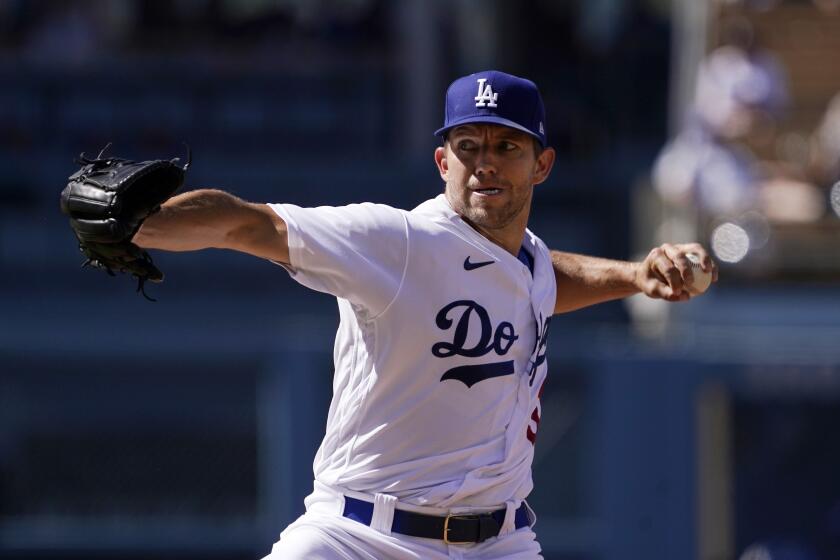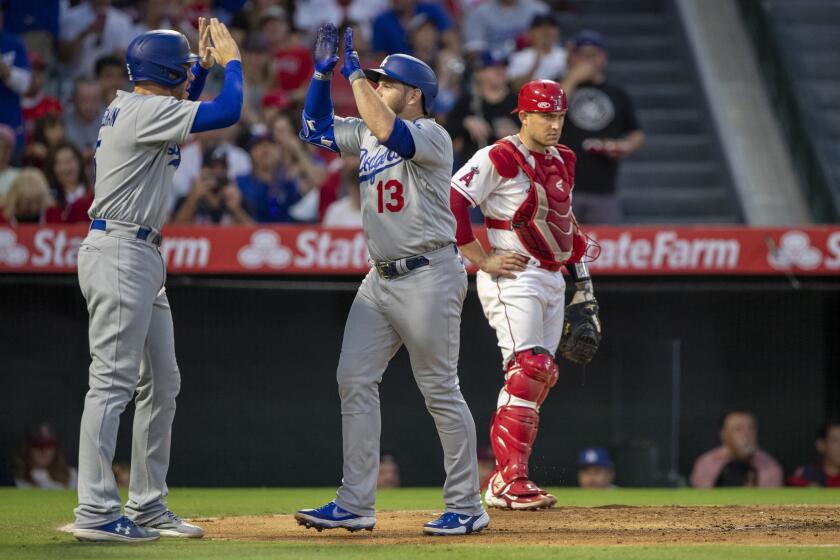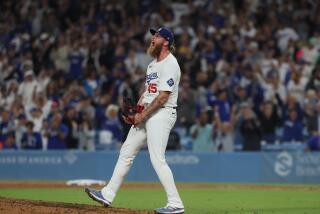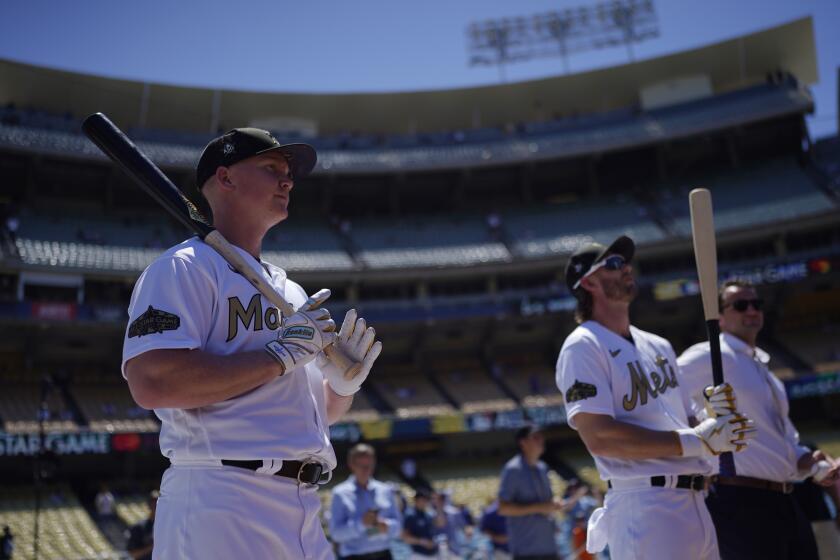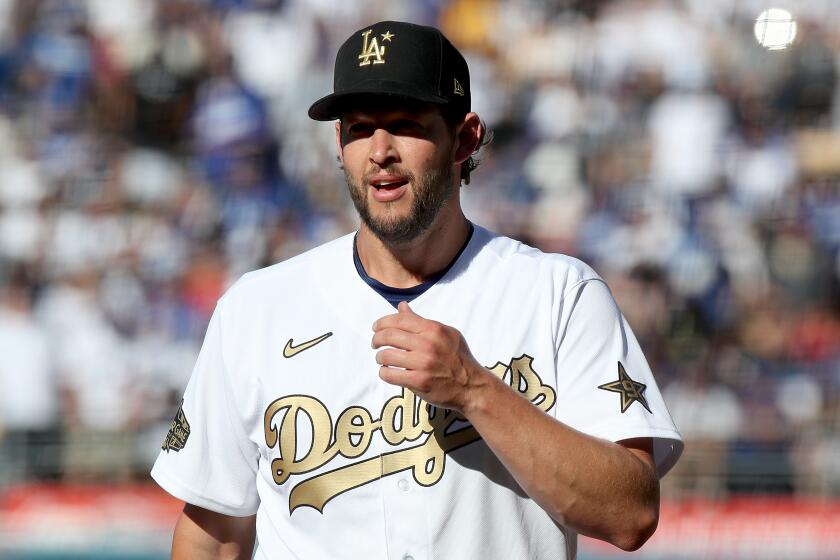‘Just write it all’: The notebook routine that helped make Tyler Anderson an All-Star
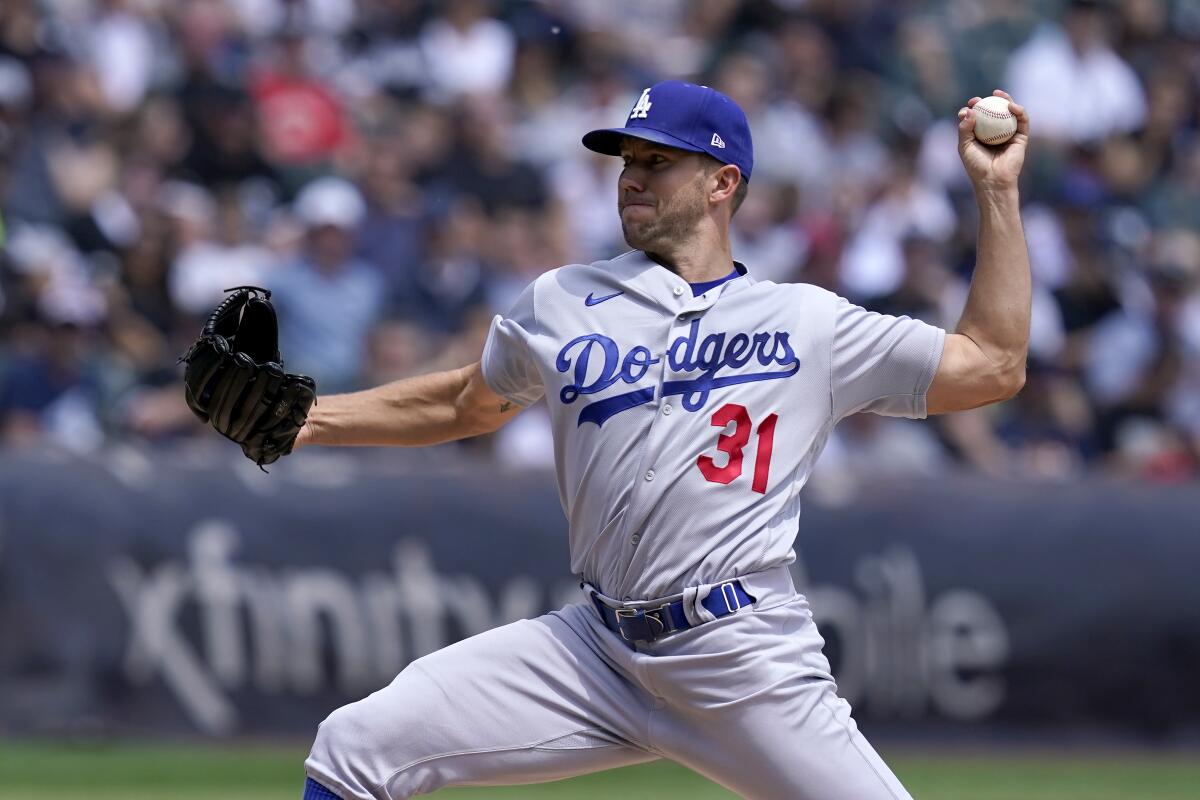
- Share via
“The brain” began three decades ago, when an up-and-coming junior college baseball coach from Southern California found himself with a Division I program for the first time.
To George Horton, becoming an assistant at Cal State Fullerton in 1990 was like “drinking water through a firehose.”
So, to keep himself organized, Horton started writing everything down in a steno pad notebook.
“It started as a recruiting notebook,” he said.
But over the rest of his coaching career, which included 11 seasons as Fullerton’s head coach and 11 more running the Oregon Ducks’ program, it became his way to keep track of almost everything the job encompassed.
Dodgers starter Tyler Anderson — who has had a spectacular first half, going 10-1 with a 2.96 ERA — is rewarded with a berth on the NL All-Star roster.
Literally, from game plans to phone numbers to mundane daily conversations, almost every single thing.
“That was my counterbalance to remember things,” Horton said. “I suffer from CDO. That’s OCD, but the letters are alphabetized like they need to be.”
Over the years, Horton’s system — nicknamed “the brain” — became legendary with his players.
Dodgers third baseman Justin Turner, a Fullerton player from 2003 to 2005, laughed when recently recalling Horton’s collection of notebooks, which were always handy to whip out at a moment’s notice.
Angels catcher Kurt Suzuki, a teammate of Turner’s at Fullerton, also chuckled when reminded of his old coach’s routine.
“The brain?” Suzuki rhetorically asked. “He carried it everywhere.”
Tyler Anderson would also crack up at Horton’s meticulous method, back when the Dodgers pitcher was on the coach’s first several teams at Oregon from 2009 to 2011.
“He would take notes of everything,” Anderson said. “His is a whole different level.”
Once Anderson got to the pros, he started to develop a note-taking process of his own.
It isn’t as intricate as Horton’s, but for the 32-year-old left-hander, it has become an important daily routine.
An indispensable baseball journal kept in a black leather notebook with an orange elastic band.
An invaluable resource that has helped the seven-year veteran navigate a journeyman big league career — and become an All-Star for the first time this season.
“It’s helped me keep a little more narrow focus,” Anderson said. “There’s a balance, but I think it’s just good to keep track of things.”
Saturday was not a normal day for Anderson.
He awoke in the morning to a call from manager Dave Roberts, informing him that after starting the season with a 10-1 record and 2.96 ERA, he had been added to the All-Star Game as a late injury replacement for the National League.
“Obviously you hope, but I wasn’t expecting it by any means,” Anderson said. “It’s a huge honor.”
He was soon serenaded with text messages from the Dodgers team group chat. When he showed up to the ballpark for the team’s series finale against the Angels, the congratulations continued.
“We got a smile out of him today,” pitching coach Mark Prior joked of the notoriously stoic southpaw. “That was nice.”
By Saturday afternoon, Anderson was even thinking about how to rearrange his family’s All-Star break plans, needing to check if their tickets for a planned trip to Disneyland this week are refundable.
“That’s a whole process,” he said with a chuckle.
There was one thing that didn’t change.
After completing some afternoon stretches, a pregame throwing session and other typical daily maintenance, he flipped open his leather Rhodia brand notebook, jotted down each activity and added to a catalog of information he has been collecting for the better part of a decade.
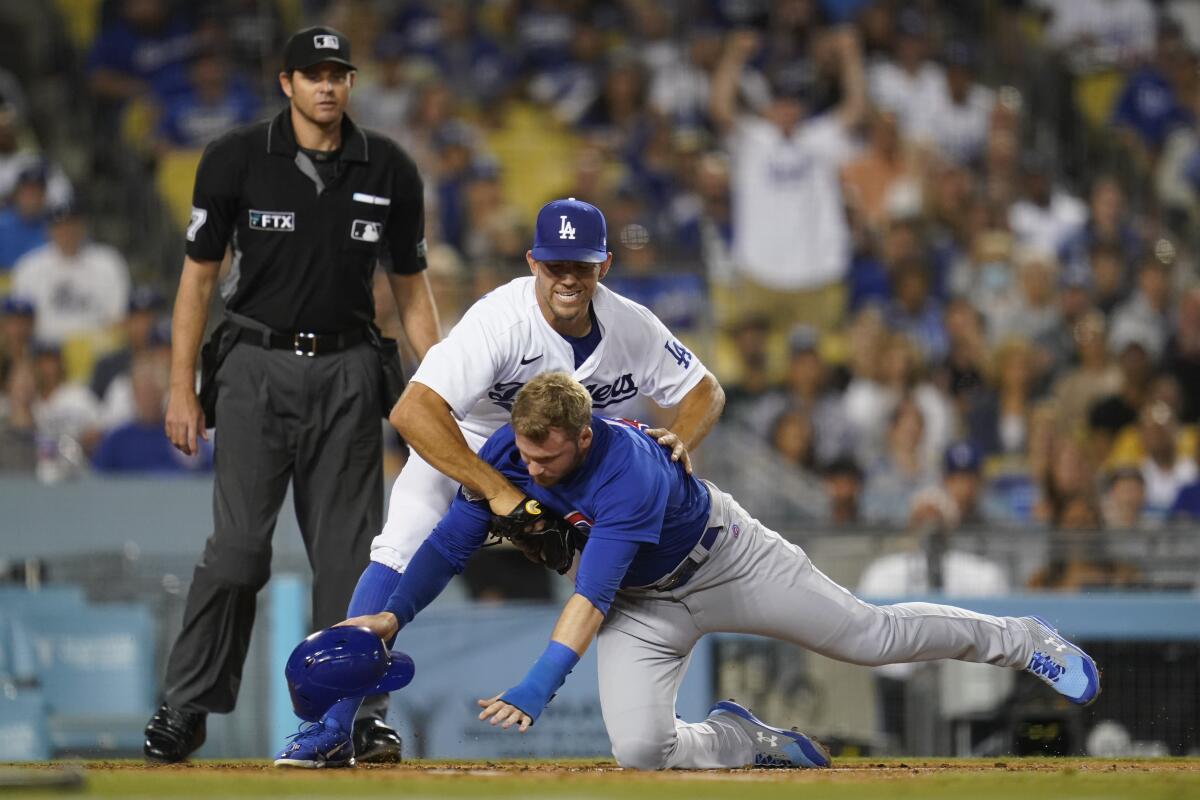
“Every day, I just write down what I do,” Anderson said.
Some examples:
“I’ll go in there and I’ll put the 12 things I do for warm-up, including stretch and shoulder stuff.”
“I’ll go play catch and I’ll write down how much I played catch.”
“Maybe if I was thinking of something when I was playing catch and it was a good cue, maybe I’ll write down what that cue was.”
“My workout, I’ll write down what it is, the sets, the reps, the weights, all that stuff. Keep track of all that, and then conditioning and getting treatment after the game or anything.”
He paused to make sure he hadn’t forgotten anything.
“I just write it all in there,” he said.
The idea was inspired by Horton, but didn’t begin until after Anderson was drafted 20th overall by the Colorado Rockies in 2011.
In college, Oregon’s program was regimented enough to keep the pitcher organized. But once he got into the minors, he realized he needed to figure out his own routine — and a way to keep track of it.
“I feel like that’s a big part of baseball, is having a good routine,” Anderson said. “So as I was going through it, I would keep track of what I would do. That way when I was doing well or feeling good, I could go back to that.”
Anderson’s notebooks — he figures he’s filled 30 or 40 by now — have been an aid throughout his up-and-down career.
Anderson broke into the big leagues with three solid seasons in Colorado from 2016 to 2018, compensating for his low-90s mph fastball velocity with a jerky delivery and complementary changeup.
After missing most of 2019 because of a major left knee surgery, however, he posted below league average numbers the last two years, spending 2020 with the San Francisco Giants and 2021 with the Pittsburgh Pirates and Seattle Mariners.
When he signed with the Dodgers this spring on a one-year, $8-million deal — bypassing longer and more lucrative offers he said he received from other teams — he didn’t even have a spot in the starting rotation, instead opening the season as a bulk reliever in the bullpen.
The Dodgers and Angels have made it to the midway of the season and find themselves in two completely opposite paths.
“I took a chance to come to this team and try to be on a winning team this year,” he said.
With his notebook in tow, resting in the cubby of his locker home and away, it has led to a first half few were expecting.
Anderson has made 15 starts, helping fill in for several injured members of the rotation. He leads the team in innings pitched (97.1), using a new grip on his changeup to unlock newfound efficiency. And his low ERA and sterling record helped him earn a first career All-Star nod he acknowledged felt like “a little validation.”
“It really does just feel like I made a good decision to come here,” said Anderson, who entered the season with a career record of 29-38 and a 4.62 ERA.
Added Roberts: “It’s something that, looking at his journey as a big league pitcher, betting on himself and wanting to sign on with the Dodgers, it just worked out really well.”
Horton has kept close tabs on Anderson’s career, from the pitcher’s days with the Rockies, whose general manager was a good friend of Horton’s; to his inconsistent recent seasons, of which Horton admitted, “I thought maybe his best bullets were already shot”; to his resurgence with the Dodgers, which included a recent pregame reunion at Dodger Stadium between the old coach and his now All-Star pupil.
“His journey, with how many speed bumps and hiccups he’s had, and his persistence and ability to stay with it and come out the other side,” Horton said, “so proud of that.”
It wasn’t until he saw a recent video featuring Anderson that was produced by the players union, however, that Horton realized his old pitcher had adopted a form of his note-taking system.
“They say the purest form of flattery is imitation,” Horton said. “I really suggested what Tyler is using it for, a journal. I think the brain works differently when you write something.”
A real brain, that is, not Horton’s notebook nickname.
Anderson keeps the his notebook going out of habit as much as anything.
“I probably don’t need the notebooks anymore,” he said. “I know what’s in there everyday.”
Still, he calls himself a visual learner. He said he likes the routine. And there’s still a part of him that takes comfort in knowing, if he does begin to struggle, he’ll have a log of thoughts, feelings and techniques to refer back to — always just a few page turns away.
“It’s a good mental reminder when you write things down,” Anderson said.
Prior said Anderson’s note-taking process isn’t too uncommon for a big league pitcher. Prior noted that former Dodgers right-hander Ross Stripling had his own note-taking habit, and joked that teammate Clayton Kershaw has “got his notebook in his brain.”
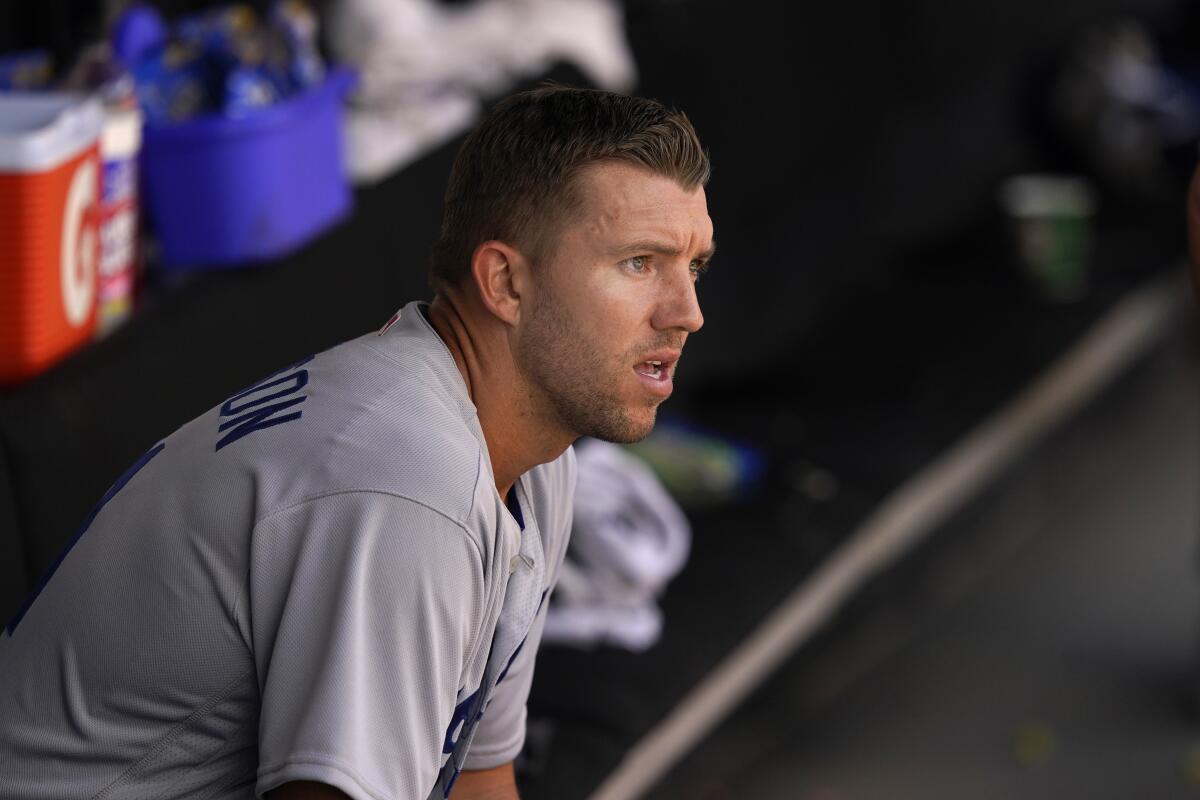
“Everybody’s got their own ritualistic way of going about it,” Prior said. “And [Anderson] is one who comes in and writes everything down.”
Instead, Prior sees it as part of Anderson’s broader approach to his methodical preparation, a trait that hasn’t gone unnoticed by the Dodgers’ staff since the pitcher joined the team this spring.
“Definitely, he’s intense,” Prior said. “He comes in with a plan every single day to get himself better, and he holds himself accountable. I think that’s the main thing. This isn’t by accident. He comes well-prepared.”
In a wide-ranging interview, MLB Commissioner Rob Manfred talks about baseball’s biggest issues, including the Angel Stadium saga and rising costs for fans.
Roberts even drew a parallel between Anderson and Kershaw, who is known for his own detailed daily routine and is a pitcher Roberts said Anderson has looked up to in his career.
“They both do their homework,” Roberts said. “They’re very well-prepared.”
This week, they’ll take part in All-Star festivities together too; Kershaw for the ninth time, Anderson for the first.
“For him to ultimately be named an All-Star,” Roberts said, “is something he’ll always remember.”
A few days’ worth of notebook entries will make sure of that.
More to Read
Are you a true-blue fan?
Get our Dodgers Dugout newsletter for insights, news and much more.
You may occasionally receive promotional content from the Los Angeles Times.

